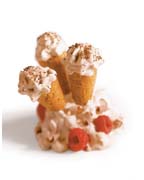
Dairy Foods magazine has talked with six global suppliers of ingredients used in the manufacture of such chilled dairy desserts. They all have experience with formulating such products, primarily through their European research and development offices.
Here's who we talked to, followed by what they had to say:
Marion Schlude, marketing manager food-nutrition & health, Cognis
Jon Hopkinson, senior project leader, special applications, Danisco
Bob Loesel, application manager-dairy, Degussa Food Ingredients
Gerard Lynch, food applications manager for Europe, FMC BioPolymer
Aileen Kacvinsky, dairy key account manager, G. C. Hahn & Co. USA Inc.
Doug Rector, group leader, functional ingredients, Kerry Bio-Science.
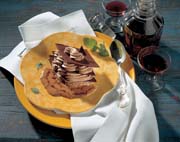
Hopkinson: Dairy desserts are sweet products that have milk as a major component. The category of dairy desserts is further divided into frozen and unfrozen products.
Rector: Chilled dairy desserts utilize the high functionality and nutritional qualities of milk to produce products such as mousse, whipped cream, flan, crème brulee, custard, cheesecake, cream pie and tiramisu.
Schlude: Well-known chilled dairy desserts include puddings and custards, with more sophisticated items being aerated mousse-style products. These light and creamy desserts are very popular with consumers today.
Loesel: Dairy dessert textures range from gelled, as in the case of pudding and flan, to creamy and spoonable, as with custard. They can also be aerated, which is the texture of mousses and whipped cream.
Kacvinsky: Dairy desserts usually do not follow any standard of identity. They may be neutral pH, directly acidified or cultured. Traditionally they are high in fat, solids and sugar, which results in an indulgent sensation.
Loesel: Some formulations are pasteurized for a standard two-week refrigerated shelflife, while others undergo ultra-high temperature (UHT) pasteurization or retort sterilization for a much longer shelflife.
Schlude: Mousses are best defined as aerated, stabilized desserts with a dry texture and foam-like consistency. Instant powder mixes have been in the market for many years, either as consumer products to be prepared at home or for the foodservice industry. Ready-to-eat mousse desserts are usually prepared from pasteurized liquid mixes that are whipped in a continuous aerator, filled into cups, sealed and cooled. The products are distributed via the refrigerated section in food stores, much like yogurt products.
Loesel: The final texture of dairy desserts comes from the interaction of carrageenan with casein and is reinforced by the use of modified starches.
Lynch: Industrially produced dairy dessert formulations are based on the traditional, homemade versions. Chilled dairy desserts can be broadly divided into two categories based on the temperature at which they are filled into containers. Hot-filled desserts such as flan are filled into cups at a temperature above the gelation temperature of the gelling ingredient. In most cases, the gelling agent is carrageenan. As the product cools in the pot, the carrageenan forms a gel network resulting in a firm texture. In contrast, cold-filled desserts, which include crème dessert, liegois and mousse, are cooled under shear while the gelling agent is in the process of setting up a network. These are usually filled at below 59
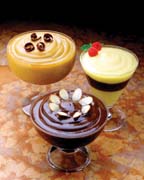
Dairy Foods: Why has it taken so long for chilled dairy desserts to catch on in the United States?
Rector: For starters, there is such a wide selection of other desserts currently available in the United States, many of which have become U.S. traditions and standards. Do consumers need or want another product? In general, these products likely were never aggressively introduced in the States because of some of the difficulties in making and distributing the products. Then take into account the fact that until consumers really started traveling around the world, second- and third-generation U.S. consumers were not familiar with these products.
Kacvinsky: The dairy case has typically been occupied by standard products such as yogurt, cottage cheese and sour cream. Slotting fees and space limit the ability to market these products, as often times these products are made by smaller, specialty companies that just cannot afford these fees and do not have the ability to get big-name retail chains to buy into their "fresh" products.
Loesel: The manufacturing and distribution processes are challenging and not widely used. Dairy desserts can be hot filled, but this technology only enables the production of gelled desserts such as pudding and flan, or basic monolayer creamy desserts such as custard. Cold filling enables the production of a wider range of textures, which leads to more sophisticated products including double- and triple-layer desserts. Furthermore, in the United States, there still are not many dairy plants equipped with aseptic processing and filling machines, which are required to guarantee the extended shelflife of the products.
Loesel: The main dairy dessert in the United States is ice cream and consumers are familiar with looking in the freezer for dairy desserts rather than in the refrigerator. This is slowly changing as packaging and technology becomes more innovative and convenient.
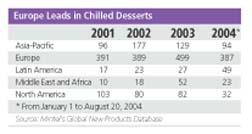
Schlude: With all the publicity on calcium and osteoporosis, consumers are very receptive to new products that help them increase their daily milk intake. Making dairy desserts at home can be quite time consuming, which is not appealing to today's on-the-go consumer; however, manufacturers are investing in the technology to make such products on an industrial scale, rendering them convenient for anytime, anywhere consumption.
Rector: Dairy's reputation has really improved in recent years as consumers understand that dairy is not only wholesome, but that lower-fat dairy products are an important part of everyone's diet. And, when consumers are on a weight-loss diet, they are looking for occasional indulgent, premium treats that are a healthy reward for sticking to their diet. Mousse is an example of a healthy reward/pleasurable experience for dieting or other life accomplishment.
Kacvinsky: Consumers are looking for different taste and product sensations. Dairy desserts satisfy these sensations while still providing a relatively healthy image when consumed. In addition, many products (such as aerated desserts) create an indulgent sensation without adding calories. The convenience factor also plays a role here as most dairy desserts are available in single-serve packaging.
Hopkinson: The changing demographics in the United States are definitely one reason why there is so much interest in chilled dairy desserts. The Hispanic population is rapidly growing and their dessert preferences are influencing the industry. I think that the restaurant trade and gourmet press have also had some influence on the trend. Products like tiramisu, mousse and the like have become very popular in recent years. There is a desire to have this type of product in a convenient ready-to-eat form for at-home or on-the-go consumption. These products are indulgent and the U.S. consumer is looking for small indulgences without the effort needed to make a dessert from scratch at home.
Loesel: The growing U.S. Hispanic population has made everyone aware of Hispanic foods, including desserts, particularly chilled desserts. Creamy dairy desserts are an important Hispanic tradition.
Rector: Consumers are also becoming more familiar with these chilled dairy desserts as a result of traveling to foreign countries and eating out at ethnic restaurants. They want to enjoy the same products on other occasions at home.
Hopkinson: I also think that the food and dairy industries in the United States are being influenced by Europe, especially since so many companies have been acquired by European businesses. The Europeans have been successfully making chilled dairy dessert products for some time. It is only natural to try to expand this market into the United States.
Dairy Foods: What are some technical challenges in making ready-to-eat chilled dairy desserts?
Hopkinson: In general these products are not difficult to make. A flan can be as simple as mixing milk, sugar, flavor and carrageenan, and hot-filling over a sugar syrup sauce. The biggest challenge is the acquisition of the proper filling machinery.
Lynch: One key challenge is to achieve a desirable texture and taste at the required formulation cost. For example, starches are widely used in several categories of dairy desserts. A small amount of carrageenan, used in conjunction with starch, can greatly improve the mouthfeel, flavor release and stability of the product. As in many applications, selection of the appropriate ingredients is critical. Most leading suppliers have developed a range of texturizing ingredients specifically for dairy desserts.
Schlude: And aeration is not a common manufacturing process in the United States, except in the ice cream industry. Therefore, investment in this technology is definitely another hurdle.
Kacvinsky: To make aerated yogurts, manufacturers simply use their current yogurt line, including filler. All they need to do is add an aerator. During aeration, the aqueous phase (dispersing agent) and the hydrocolloids (a combination of thickening and gelling agents) dissolved in this phase are united by gas, or air, at high turbulence. Emulsifiers reduce the interfacial tension. What's very important here is hydrophilic-lipophilic balance. The mixing head of the aerator or mixer crushes the gas bubbles mechanically. You want homogenous dispersion of the gas bubbles followed by stabilization.
Schlude: Instead of using an aerator for whipping, mousse can be produced in an ice cream freezer. This provides ice cream producers with an excellent opportunity to obtain a better utilization of their plants outside the peak season. The mousse mix can be fed into the freezer at a temperature up to 77
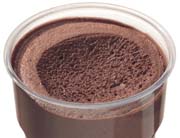
Source: Cognis
Dairy Foods: Besides milk, what are some of the key ingredients in dairy desserts?
Lynch: The main ingredients tend to be sugar, starch, flavor and hydrocolloids, in particular carrageenan. Egg-derived ingredients are used in some desserts such as crème brulee. Emulsifiers are used in aerated desserts such as chocolate mousse.
Kacvinsky: Dairy ingredients such as milk protein concentrate or whey protein concentrate, as well as nonfat dry milk, could also be used in formulating chilled dairy desserts. Sugar replacements are showing up more and more in lower-calorie products.
Schlude: With increasing interest in lower-calorie foods, high-intensity sweeteners can be used to replace some or all of the sugar in some dairy dessert formulations. For example, sugar in mousse recipes provides not only sweetness, but also total solids. By replacing sugar with a high-intensity sweetener, the same degree of sweetness can be reached, but the product lacks a certain amount of total solids. This may be compensated by partially replacing the sugar with some high-intensity sweetener and partly by fructose, which is about 50% sweeter than a comparable amount of sugar. Body and mouthfeel can be further improved through the addition of inulin. The inulin can also be declared as dietary fiber, which is an additional nutritional advantage.
Hopkinson: Perhaps the one key ingredient in this kind of product is flavor. If these products are to be marked to adults as indulgent it is absolutely imperative that the flavor of the product be impeccable. Fat can also play an important role since many of these products are considered to be indulgent. The key ingredients may change based on the product and how the consumer is going to prepare and consume it.
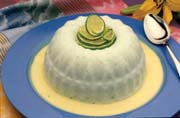
Loesel: In the case of pudding or flan, carrageenan gels the dessert to make it easy to unmold. With creamy desserts, carrageenan brings consistency and thixotropic behavior, which when combined with modified starches, leads to the desired final texture.
Lynch: In cold-filled desserts, carrageenan is used mainly to provide texture. Texture and flavor release are greatly improved by using a combination of carrageenan and starch instead of starch alone. The texturizing synergy between special grades of carrageenan and most starches means that this product improvement often comes at no additional formulation cost.
Kacvinsky: Overrun, though not technically an ingredient as it is simply air, is very important, particularly in mousse and whipped cream. It creates a sensation of lightness in the product, as well as overall texture and mouthfeel. Depending upon the amount of air incorporated, the texture and spreadability of the product can be altered.
Schlude: If a product containing overrun is stabilized properly, the consumer does not feel "cheated" but just enjoys the light dessert and creamy mouthfeel.
Loesel: Usual overrun for yogurt mousse is 50% to 80%. For neutral pH mousse, it is 100% to 130 %. And for whipped cream, it is much greater. It is closer to 200% to 250 %. The incorporation of air or gas improves mouthfeel, adds creaminess and imparts good flavor release.
Rector: There are upper and lower limits to overrun. Not enough could result in a product that lacks richness, while too much can make a product appear cheap.
Lynch: In some markets, small uniform-sized air bubbles are preferred. In these cases, gelatin is often used. In other situations, product differentiation is desired. For example, special grades of alginates are used to achieve a mousse with a more open air structure. This can give the consumer a homemade perception.
Dairy Foods: Please provide readers some useful formulating tips using specific ingredients.
Hopkinson: The Grindsted® Lactem series of lactic acid esters of monoglycerides is a range of emulsifiers that can improve overrun and foam stability, as well as provide homogeneity to commercial mousse and yogurt mousse. Also, the Grindsted Carrageenan CL FLX series is a new line of carrageenans designed specifically for desserts. They can be selected for textures from low- to high-gelled appearance and from soft-creamy to creamy-elastic mouthfeel. These carrageenans can be cold filled, which opens up the possibility of filling in many different patterns including horizontal and vertical layering.

Schlude: Lamequick® whipping agents are spray-dried functional powders based on vegetable fat, emulsifier and milk protein, which allow for desserts with high overrun. These desserts are at the same time low in calories and creamy in mouthfeel. Desserts based on Lamequick have been shown to be creamier than same-fat-level desserts that are based on pure emulsifiers. Also, when Lamequick is used in a mousse with a finished product fat content of 4%, the texture is as creamy as in a mousse containing 6% to 8% fat plus emulsifiers.
Lynch: For many years, the use of alginate in chocolate mousse was limited because of the reactivity of alginate with calcium in cold milk, which generates a high viscosity and high pressure in plate heat exchangers. To overcome this limitation, a range of products was developed including Protanal® DP 5340, which is recommended when it is possible to add alginate directly to hot milk. In cases where this is not feasible, Protanal GP 2055 and Protanal XP 3553 can be added directly to cold milk. Protanal XP 3553 has been specially engineered to be activated after the homogenization and heat exchange steps, avoiding any viscosity or pressure build-up. As a result, it can be included in a formulation without any adjustment to the manufacturing plant.
Rector: When making flan, Sherex® DE 1359 can be used if a soft, elastic texture is desired, while Sherex DE 1286 produces a more firm and brittle texture. For aerated desserts, Hygel® 8293 is used as a high-performance whipping protein. It gives high overrun foam with small uniform air cells.
Kacvinsky: Stabilizer systems are really application specific and so often customization is necessary. The Hamulsion® line of stabilizer systems are specifically designed to provide body as a thickening agent and for emulsification. There are a range of Hamulsion blends, and they are generally comprised of a number of hydrocolloids, emulsifiers and/or salts. For example, Hamulsion SWM would be used to make plain yogurt, and then when aerating the yogurt, Hamulsion SMM would be used to stabilize the foam.
Dairy Foods thanks these six experts for sharing their knowledge of the increasing popular category of chilled dairy desserts.
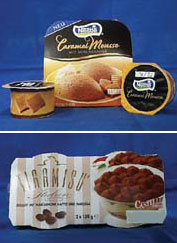
Sidebar: New Products are Plentiful
Chilled dairy desserts are not just chocolate pudding. They are chocolate pudding layered with whipped cream and topped with a drizzle of rum.According to Mintel's Global New Products Database, Europe leads the world in the number of new chilled desserts introduced annually. Asia follows. Here are descriptions of some of the more unique innovations to hit grocers' refrigerated cases in recent years.
In Japan, Ohayo Dairy Products introduced Ohayo Baked Sweet Potato Pudding, which is made with milk and fresh eggs that are cracked daily at the company's own plant. The company also offers Ohayo Jersey Milk Coffee Pudding, which is made with rich Jersey cows milk.
In the United Kingdom, Gü Rensow Patisserie rolled out Little Chocolate Puds, which are mini chocolate-based desserts (50g) targeted to consumers who want a chocolate hit without piling on the pounds. The mini puds come in two varieties: Cheeky (chocolate and orange truffle) and Boozy (chocolate and Amaretto truffle).
Loseley Chilled Products, also in the United Kingdom, teamed up with spirits producers Allied Domecq to produce a range of liqueur-cased chilled desserts called Malibu Tropical Trifle, Tia Maria Tiramisu and Harvey's Bristol Cream Trifle.
In France, Nestlé launched Choc', a milk chocolate and caramel dessert featuring the shadow of a devil's trident on the package, hinting at the naughtiness of indulging in this dessert.
Across Europe, Bonne Maman has extended its dessert range to include Crème Brûlée, which comes in a glass pot with a gingham-like top and includes a separate sachet of brown cane sugar for burning on top.
In South Africa, Woolworths introduced Brandy Tipsy Pudding, an old Cape classic filled with pecan nuts and dates, and drenched in a brandy sauce.

In Belgium, Nestlé added milk chocolate mousse to its Sveltesse range, which contains only 1.9% fat, while in France, Danone introduced under its Taillefine brand, Crème aux Oeufs au Chocolat, a chocolate dessert cooked with eggs and fat-free cream containing only 3.3% fat per serving.
In the United Kingdom, Danone introduced to its Goodies range a low-fat chocolate mousse with cream topping called Light'n Bubbly Chococcino. In Israel, Solo Italia introduced Tiramisu Light, a sponge cake, coffee and cream dessert containing only 143 calories per serving.
There have not been many introductions of functional and fortified chilled desserts, meaning there might be some potential for growth in the segment. However, this might be happening because desserts are usually seen as a treat, not something to be eaten regularly as a health food that will improve the nutritional quality of the consumer's diet. In France, Carrefour added to its J'Aime range a vanilla pudding with fructooligosaccharides and added calcium, while in nearby Germany, Goldhand Vertriebsgesellschaft introduced under its Tip brand a probiotic peach-passion fruit dessert.
Ethnic desserts are a niche segment in the chilled desserts category. As consumers travel more and become more accustomed to exotic flavors and textures, they want to be able to buy those desserts when they are back home. In the United Kingdom, Mumtaz Food Products introduced Rassmalai, a traditional Kashmiri dessert made with curds, pistachio and almonds and flavored with spices such as cardamom. In Germany, Hazer Baba introduced Halva Pistachio, a traditional sweet specialty from Turkey that is made from pressed sesame and refined with pistachio.
